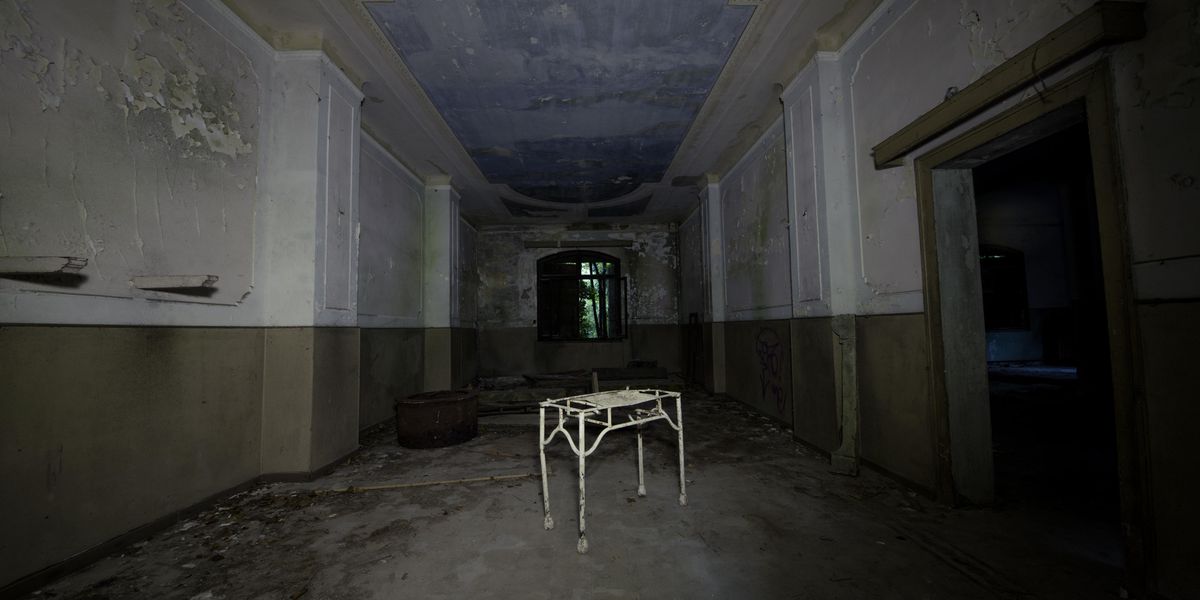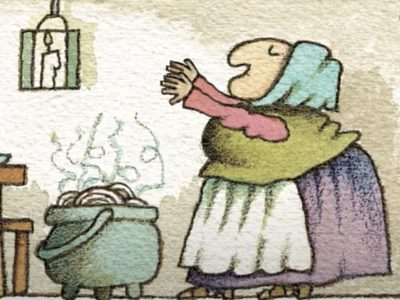Updated Oct. 30, 2024 at 3:10 p.m.*
When Hallows Eve was first introduced as a Celtic festival some 2,000 years ago, bonfires and costumes were seen as a legitimate way to ward off ghosts and evil spirits. Today of course, with science and logic being real ghostbusters, spine-chilling tales of haunted forests, abandoned asylums and deserted graveyards have rather become a way to add some mystery and suspense to our lives.
✉️ You can receive our Bon Vivant selection of fresh reads on international culture, food & travel directly in your inbox. Subscribe here.
And yet there are still spooky places around the world that have something more than legend attached to them. From Spain to Uzbekistan and Australia, these locations prove that haunting lore is sometimes rooted in very real, and often terrible events.
Castle of Good Hope – South Africa

The entrance to the Castle of Good Hope
Near the shoreline of Table Bay in Cape Town, the Castle of Good Hope was built in 1666, making it the oldest colonial building in South Africa. Originally intended to be a replenishment station for ships, the site eventually served as a military fortress and prison during the Second Boer War from 1899 to 1902.
A section of the castle served as a torture chamber and a gallows. It has been said that the ghost of an 18th century governor remains there to this day — and reports of sightings have become regular.
In the 1700s, Governor Pieter van Noodt condemned seven men to be hung to death for desertion, one of the men cursed the governor from the gallows, he then died of a heart attack later that day. Legend says he died with a look of surprise on his face.
Today you can tour the fort and see all of its sights — including the torture chamber. You can go with others, or enter alone…
Belchite, Civil War massacre – Spain

Old Belchite, Spain
Shy lost souls wandering and briefly appearing in front of visitors, unexplainable forces attracting some to specific places of the town, recorded noises of planes, gunshots and bombs, like forever echoes of a drama which left an open wound in Spanish history…
That wound, still unhealed, is the Spanish Civil War; and at its height in 1937, Belchite village, located in the Zaragoza Province in the northeast of Spain, represented a strategic objective of the Republican forces to take over the nearby capital city of Zaragoza.
Instead of being a simple step in their operation, it became the field of an intense battle opposing the loyalist army and that of General Francisco Franco’s. Between August 24 and September 6, more than 5,000 people were killed, including half of Belchite’s population. The town was left in rubble. As a way to illustrate the Republicans’ violence, Franco decided to leave the old town in ruins and build a new Belchite nearby. All the survivors were relocated there, but they had to wait 15 years for it to be complete.
If nothing particular happens in new Belchite, home to around 1,500 residents, the remains of old Belchite offer their share of chilling ghost stories. Some visitors say they felt a presence, someone watching them, sudden change of temperatures and strange sounds. The ruins of the old village have been used as a film set for Terry Gilliam’s The Adventures of Baron Munchausen – with the crew reporting the apparition of two women dressed in period costumes – and Guillermo del Toro’s Pan’s Labyrinth. And in October 1986, members of the television program “Cuarta Dimensión” (the 4th dimension) spent a night in Belchite and came back with some spooky recordings of war sounds.
Isla de las Munecas – Mexico

Dolls hanging on trees on Isla de las Munecas.
Isla de las Munecas, or Island of the Dolls, located south of Mexico City between the canals of Xochimico, is a small island dedicated to the lost soul of a girl — and home to hundreds of terrifying dolls.
The dolls, which all have severed limbs, decapitated heads, and blank eyes, hang on trees around the island.
Legend says that a girl drowned in mysterious circumstances years ago on the island, and that the dolls are possessed by her spirit. Some locals even say that the dolls move their heads and arms and even open their eyes. Some witnesses claim that they had even heard the dolls whispering to each other, others who were on a boat said the dolls lured them to come to the island.
The story goes that Julian found a little girl who has drowned and he was not able to save her life. Afterward, Julian saw a floating doll near the canals. Most probably belonging to the girl.He picked up the doll and hung it on a tree in order to respect her spirit. Julian was apparently haunted by the spirit of the girl and started hanging more dolls in an attempt to please her spirit. He soon realized the dolls themselves were possessed as well, and eventually hung them over the entire island.
After 50 years of collecting dolls and hanging them on the island, Julian was found dead, drowned in the same spot where the girl did. Many people on the island believe that Julian has joined the other spirits of the island.
Eltz castle, like in a dark tale from the Grimm Brothers – Germany

Aerial view of Eltz castle, 2018.
Niels Tichelaar/Amazing Aerial via ZUMA Wire
Few places in Europe look so much like a lair of villains and abode of nightmares — dark ravens circling the towers, lightning flashing in the black sky — as the marvelous Eltz castle. Nestled in the hills above the Moselle River in the Western land of Rhineland-Palatinate, it’s one of the oldest and best preserved castles in Germany.
Dating back to the 12th century, it’s one of the rare castles in Europe which has stayed in the same family for over 850 years, surviving bloody wars and the ravages of time. The family was forced to endure a deadly siege inside the castle between the years 1331 and 1336.
Picture steep, timber-framed towers, fairy-tale turrets, and walls that seem to rise right out of the forest mist. Built on a rock outcrop and surrounded by lush woods, Eltz feels like it leapt straight out of a dark tale by the Grimm Brothers.
Inside, you’ll find armor, tapestries, and intricate furnishings that capture life from the medieval period onward. The castle’s eight towers and many rooms show a blend of Romanesque and Gothic architecture, each filled with quirky details and historical artifacts.
Bhangarh Fort – India

A part of the Bhangharh Fort
With a large sign prohibiting visitors post-sundown, the Bhangarh Fort remains being known as the most haunted site in India. Located in Rajasthan’s Alwar district, the first was built by Raja Bhagwant Das for his younger son, Madho Singh.
The fort complex was eventually abandoned, and many legends circulate as to why the fort is now haunted.
One says that a local ascetic demanded that no house in the vicinity should cast a shadow on his home, he then cursed the fort after the structure created a shadow on his property.
Another legend says a black magician or evil saint fell in love with a princess from the fort complex and attempted to use a love potion on her. The princess then threw the potion onto a boulder, which then rolled back to the magician, and ended up physically crushing him. Before his final breath, he cursed the fort, that it would end up in a state in which no one could live in it. And so it has been.
Shahr-e Gholghola, City of Screams – Afghanistan

The ruins of Shahr-e Gholghola, the City of Screams, in Afghanistan
According to locals, ghosts from this ancient royal citadel located in the Valley of Bamyan, 150 miles northwest of Kabul, have been screaming for 800 years. You can hear them from miles away, at twilight, when they relive their massacre.
In the spring 1221, the fortress built by Buddhist Ghorids in the 6th century became the theater of the final battle between Jalal ad-Din Mingburnu, last ruler of the Khwarezmian Empire, and the Mongol Horde led by Genghis Khan. It is said that Khan’s beloved grandson, Mutakhan, had been killed on his mission to sack Bamyan. To avenge him, the Mongol leader went himself and ordered to kill every living creature in the city, children included.
The ruins today bear the name of Shahr-e Gholghola, meaning City of Screams or City of Sorrows. The archeological site, rich in Afghan history, is open to the public and though its remaining walls stay quiet during the day, locals say that the night brings the echoes of fear and agony. Others claim the place comes back to life eight centuries ago, and one can hear the bustle of the city and people calling each other.
Gettysburg, Civil War battlefield – U.S.

View of the battlefields from Little Round Top, Gettysburg, PA, USA
Even ghosts non-believers agree there is something eerie about Gettysbury. The city in the state of Pennsylvania is now one of the most popular destinations in the U.S. for spirits and paranormal activities sight-seeing; and many visitors report they witness exactly what they came for: sounds of drums and gunshots, spooky encounters and camera malfunctions in one specific spot … just to name a few!
The Battle of Gettysburg, for which President Abraham Lincoln wrote his best known public address, is considered a turning point in the Civil War that led to the Union’s victory. It lasted three days, from July 1st to July 3rd, 1863, but it accounts for the worst casualties of the entire conflict, with 23,000 on the Union side (3,100 men killed) and 28,000 for the Confederates (including 3,900 deaths). Thousands of soldiers were buried on the battlefield in mass graves – without proper rites, legend says – before being relocated to the National Military Park Cemetery for the Unionists.
Since then, legend has it, their restless souls wander, unaware the war has ended. You can find them everywhere, on the battlefield or in the town’s preserved Inns and hotels turned into field hospitals back then.
Gur Emir, a conquerer’s mausoleum – Uzbekistan

Gur Emir (Tomb of Timur) in Samarkand, Uzbekistan
Chris Bradley/Design Pics via ZUMA Wire
The news echoed through the streets and bazaars of Samarkand: “The Russian expedition will open the tomb of Tamerlane the Great. It will be our curse!” It was June 1941, and a small team of Soviet researchers began excavations in the Gur-Emir mausoleum in southeastern Uzbekistan.
The aim was to prove that the remains in the tomb did in fact belong to Tamerlane — the infamous 14th-century conqueror and first ruler of the Timurid dynasty who some historians say massacred 1% of the world’s population in 1360.
Still, on June 20, despite protests from local residents and Muslim clergy, Tamerlame’s tomb was cracked open — marked with the inscription: “When I Rise From the Dead, The World Shall Tremble.”
Only two days later, Nazi Germany invaded the Soviet Union, with the people of Samarkand linking it to the disturbing of Tamerlane’s peace. Amid local protests, the excavation was immediately wrapped up and the remains of the Turkish/Mongol conqueror were sent to Moscow. The turning point in the war came with the victory in the Battle of Stalingrad — only a month after a superstitious Stalin ordered the return of Tamerlane’s remains to Samarkand where the former emperor was re-buried with full honors.
Gamla Stan, a royal massacre – Sweden

The red house of Gamla Stan, Stockholm, Sweden
After Danish King Kristian II successfully invaded Sweden and was anointed King in November 1520, the new ruler called Swedish leaders to join for festivities at the royal palace in Stockholm. At dusk, after three days of wine, beer and spectacles, Danish soldiers carrying lanterns and torches entered the great hall and imprisoned the gathered nobles who were considered potential opponents of the Danish king. In the days that followed, 92 people were swiftly sentenced to death, and either hanged or beheaded on Stortorget, the main square in Gamla Stan (Old Town).
Until this day, the Stockholm Bloodbath is considered one of the most brutal events in Scandinavian history, and some people have reported visions of blood flowing across the cobblestoned square in early November. A little over a century later, a red house on the square was rebuilt as a monument for the executed — fitted with 92 white stones for each slain man. Legend has it that should one of the stones be removed, the ghost of the represented will rise from the dead and haunt the streets of Stockholm for all eternity.
Port Arthur, gruesome prison – Australia

Port Arthur Prison Settlement, Tasmania, Australia
During its 47-year history as a penal settlement, Port Arthur in southern Tasmania earned a reputation as one of the most notorious prisons in the British Empire. The institution — known for a brutal slavery system and punishment of the most hardened criminals sent from the motherland— claimed the lives of more than 1,000 inmates until its closure in 1877.
Since then, documented stories have spanned the paranormal gamut: poltergeist prisoners terrorizing visitors, weeping children roaming the port and tourists running into a weeping ‘lady in blue’ (apparently the spirit of a woman who died in childbirth). The museum even has an ‘incidence form’ ready for anyone wanting to report an otherworldly event.
Poveglia Island, plague victims – Italy

Poveglia Island, Italy
Mirco Toniolo/ROPI via ZUMA Press
Located off the coast of Venice and Lido, Poveglia sadly reunites all the classical elements of a horror movie: plagues, mass burial ground and mental institute (from the 1920’s).
During the bubonic plague and other subsequent pandemics, the island served as a quarantine station for the sick and anyone showing any signs of what could be Black Death contamination. Some 160,000 victims are thought to have died there and the seven acres of land became a mass burial ground so full that it is said that human ash makes up more than 50% of Poveglia’s soil.
In 1922 a retirement home for the elderly — used as a clandestine mental institution— opened on the island and with it a fair amount of rumors involving torture of patients. The hospital and consequently the whole island was closed in 1968, leaving all the dead trapped off-land.
Poveglia’s terrifying past earned it the nickname of “Island of Ghosts”. Despite being strictly off-limits to visitors, the site has been attracting paranormal activity hunters looking for the apparition of lost and angry souls. The island would be so evil that some locals say that when an evil person dies, he wakes up in Poveglia, another kind of hell.
*Originally published Oct. 31, 2023, this article was updated Oct. 30, 2024 with information on the Eltz castle in Germany.
From Your Site Articles
Related Articles Around the Web










